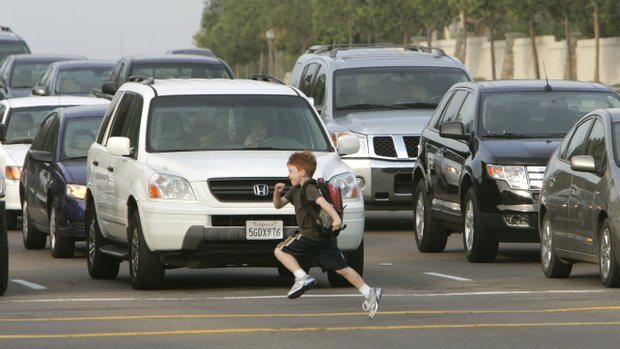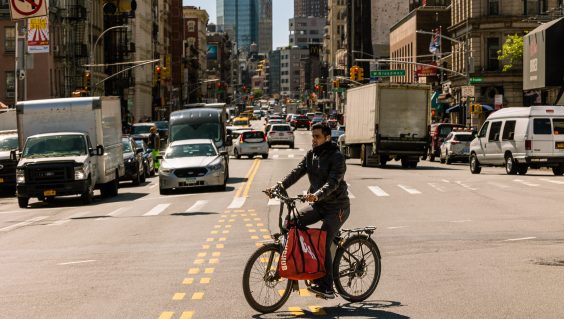Book Excerpt: “Dead End,” a Look at Sprawl and the Rebirth of Urbanism
1:48 PM EDT on April 22, 2014
"Dead End: Suburban Sprawl and the Rebirth of American Urbanism" is a new book by Ben Ross, longtime president of Maryland's Action Committee for Transit and a frequent contributor to Greater Greater Washington. This excerpt is preceded by a section describing the post-war expansion into the suburbs and the surrender of public space to automobile traffic. Highways proliferated, congestion worsened, children's play was prohibited in the street and often in the sidewalk, and pedestrians were engineered out of the roadway.
There was a subtle but profound alteration in the way street corners are built. Curbs no longer meet at right angles; they swing around in broad curves. It became standard even in cities for the curb to start bending back 25 feet from the cross street. On busy suburban roads, the bend begins even farther from the corner. Those on foot must choose between dangerous crossings of broad asphalt expanses and annoying zigzags to where the road narrows. Cars round the turn at highway speed. The simple act of walking down the street is so perilous that pedestrians are sometimes warned to wear reflective clothing, as if they were in the woods during hunting season.

These changes were no mere whim of car-loving traffic engineers. Behind them stood the lobbying might of the trucking industry.
The truckers had fought for decades to put bigger vehicles on the roads, but they were long stymied by the railroads. A major battleground was Pennsylvania, where the Pennsylvania Railroad held sway over the legislature and limits on trucks were especially strict. A few weeks before the 1950 election, the Pennsylvania Motor Truck Association divided $76,000 between the chairpersons of the state Democratic and Republican parties. It was, the association’s treasurer later conceded under oath, like betting on both teams at a baseball game, but he countered that “nothing was hidden, it was all out in the open.”
The truckers gained ground in the 1970s as their old antagonists weakened. But they still faced strenuous opposition from local governments and the American Automobile Association. Even highway engineers objected; they worried that bridges weren’t built to carry the weight of big trucks. Just before the 1974 election, the Truck Operators Nonpartisan Committee made last-minute campaign contributions to 117 congressional candidates from both parties. Six weeks later, the House of Representatives reversed an earlier vote, and weight limits were raised on interstate highways.
In December 1982, the truckers won full victory. The Reagan administration agreed to their demands in exchange for the industry’s acceptance of a tax increase that hit trucks harder than autos. Weight limits were raised again, and state limits on the length and width of trucks were overruled. Tractor-trailers could have trailers up to 48 feet long; soon the limit in most places was 53 feet.
A key provision, not fully understood by critics when the law was rushed through a lame-duck Congress, legalized the big trucks on many local roads as well as on the interstates. Road-builders had a new justification for designs that encourage cars to speed; pedestrians, ignored when the issue was under debate, were the victims. Lanes grew wider; curbs were pushed back at intersections so that extra-long vehicles could make the turn. And, because it was written into the statute, the neighbors had no way to object.
*****
America, at the end of the millennium, could seem like one big subdivision. The suburban status-seeking impulse had acquired a life of its own. As it marched down the social totem pole, each layer of society in turn imitated those above. Fed by a vast complex of vested interests, it had swatted away the scorn of intellectuals and the lawsuits of integrationists. It overpowered even the political muscle of the real estate developers who first set it in motion. In city and town alike, single-family houses and automobiles were the unquestioned normal; any other mode of life seemed somehow deviant.
A formidable apparatus of covenants, zoning ordinances, and historic districts protected the residential pecking order. These devices preserved more than neighborhoods; they maintained status distinctions inherited from long-past eras. The 1890s, when city folk looked down on the agricultural masses, lived on in rules against farm animals. The 1920s motorist’s disdain for streetcar suburbs imposed off-street parking minimums. Preservation boards continued the 1960s search for authenticity.
But status symbols lose their power when everyone has them. The prestige of suburbia failed to impress those who grew up knowing no other life, and the values of a new generation clashed with inherited institutions. The first challenges to the suburb’s superiority over the city came in the sixties with the apartment boom and the beginnings of gentrification. By the end of the millennium, suburban living was clearly losing cachet. Highway builders still poured concrete and zoning boards chased away apartments, but the emotional foundation of the entire structure was rotting away.
Shifting status rankings were reflected in popular culture. The late fifties and sixties were the years of TV sitcoms like Leave It to Beaver and Ozzie and Harriet. Suburban families lived the only life that was truly normal. A partial return to the city accompanied the gentrification wave of the seventies and similarly petered out in the Reagan years. Then in the late nineties, following the success of Seinfeld, Manhattan was glamorized in Sex and the City and a flood of other shows. The suburbs were hardly forgotten, but they had a new image; it was a long way from the family in Father Knows Best to the one in The Sopranos. By 2010 the return to the city could be taken for granted; Manhattan was almost passé as Brooklyn turned trendy.
Status symbols were eroding right in front of the house. On mid-century lawns, homeowners labored to keep lawns carefully mowed and to exclude broad-leafed crabgrass from their precious turf. The intrusive species was such a symbol of suburban living that Kenneth Jackson’s history of the suburbs, published in 1985, was titled Crabgrass Frontier.
Once sod grew in front of rich and poor alike, it lost prestige. Manicured lawns have hardly disappeared; many homeowners like the look. But they are no longer a national obsession. The war against crabgrass has ended in surrender; people under thirty barely know what Kenneth Jackson’s title means. Google in 2009 rented a herd of goats to nibble down the turf around its headquarters, and this once-forbidden practice has become a fad. Cities are changing their laws to allow grazing in residential zones.
Even the quintessentially suburban game of golf is losing its allure. In 2011 in the United States 11% fewer rounds were played than in 2000. The number of golf courses peaked in 2005 and began to decline.
Yet the norms of suburbia remain deeply ingrained. Homeowners still wedded to the old values—among them most civic association leaders and many government officials—find it inconceivable that others might want to live differently. Affluent city dwellers, when too numerous to be ignored, are dismissed as hipsters acting out a soon-to-be-outgrown stage of immaturity.
Suburban nonconformity still meets stiff resistance, with concessions made only grudgingly. Nature lovers let their lawns go to seed, and neighbors demand strict enforcement of grass-cutting ordinances. A Michigan woman, in 2011, was threatened with three months in jail for growing vegetables in front of her house.
Bitter battles erupt between adherents of the now-fashionable “locavore” movement and defenders of the long-standing exclusion of farm animals from residential zones. When Montgomery County moved to legalize backyard henhouses, sharp criticism came from both wealthy Chevy Chase and more modest neighborhoods. At a public hearing, one witness called the proposal “a cultural slap in the face” at African Americans who had grown up poor. With success, she said, “they left behind the poverty and the stigma of racism associated with the chickens. For many that achievement included a suburban single-family home and neighborhood.”
Elsewhere zoning boards debate at length the fine distinctions between unproductive pets, which homeowners may harbor, and useful livestock that are proscribed. This last issue came to a head in Belmont, California, which advanced the cause of scientific land use planning by pioneering the separation of pet goats from farm animals. The city’s lawmakers adopted a 1600-word ordinance laying down conditions under which pygmy goats of the species Capra hircus may be raised in residential zones.
Stay in touch
Sign up for our free newsletter
More from Streetsblog USA
Who’s to Blame for Tuesday’s Headlines?
Are the people in this photo inherently "vulnerable", or is this car just dangerous?
Why Riders With Disabilities Have To Sue For Accessible Transit Stops
A Bay Area transit agency is only the latest to be sued over inaccessible stations. What will it take to get every American stop ADA compliant?
Monday’s Headlines Reconnect With Pete
More than $3 billion is flowing out of the White House to help correct infrastructure mistakes in Black communities.
‘Buy, Bully, Bamboozle’: Report Shows App Companies Threaten Democracy
App delivery companies seek to block worker-led improvements by spending big money on political influence, leveraging their data, and even co-opting progressive language, argues a new report that lands days before a national one-day strike by app-workers.
How the Myth that ‘100 Companies’ Are Responsible for Climate Change Hides the True Impact of Automobility
An influential report pins responsibility for the climate crisis to just a handful of oil, gas and cement producers. But who's buying what they're selling — and who's creating policy that makes many of those purchases functionally compulsory?




